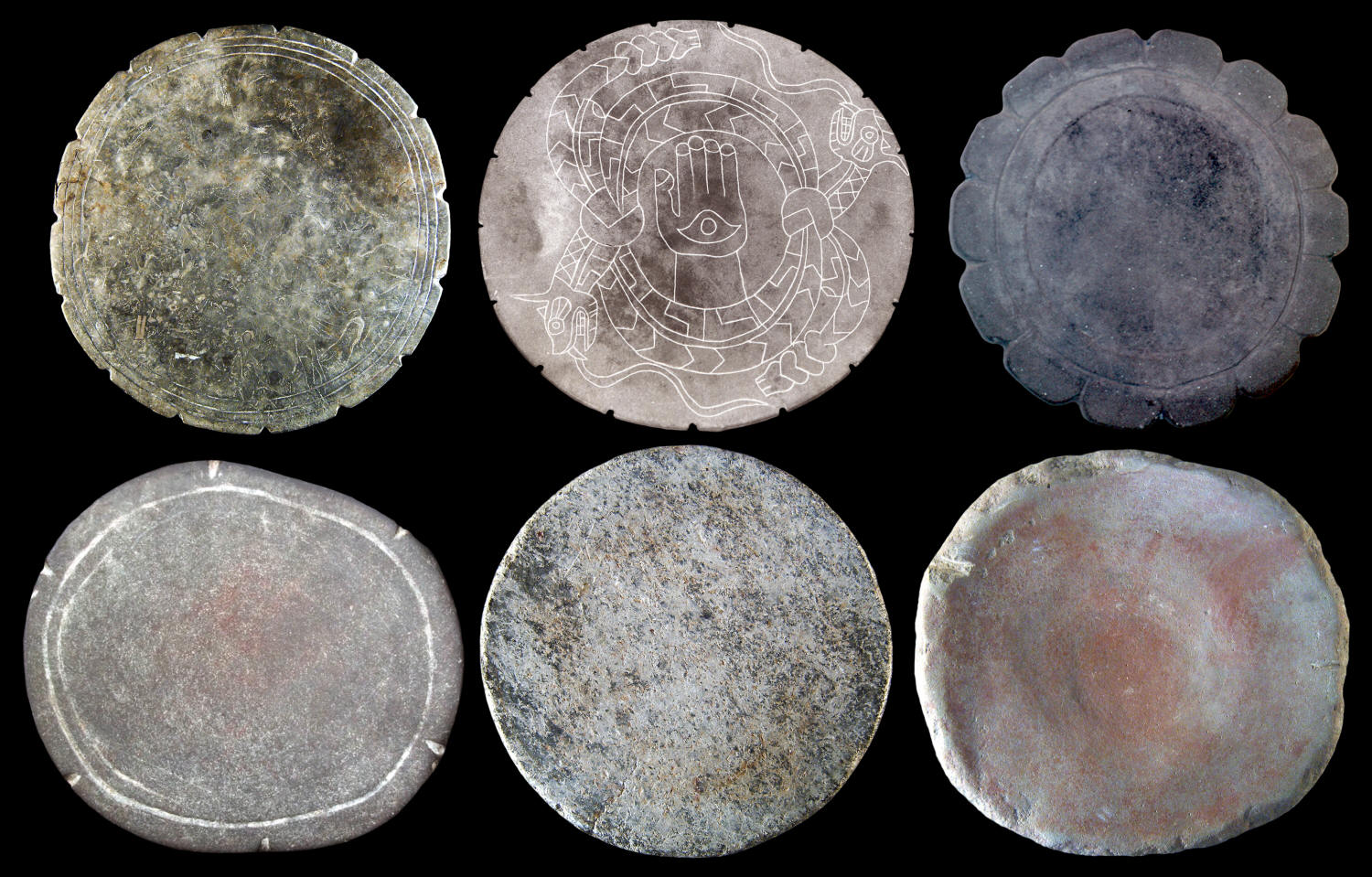|
STONE DISC PALETTES
ALABAMA, ILLINOIS, MISSOURI,
TENNESSEE
RETURN TO PAGE 1
COPYRIGHT
OCTOBER 31, 2011 PETER A. BOSTROM
These six stone disc palettes are
reported to have been found on sites in Alabama, Illinois, Missouri
and Tennessee. They are all Mississippian culture artifacts.
The disc at top left was found in 1975 during excavation of
the Campbell site in Pemiscot County, Missouri. This palette was
discovered in association with a burial along
with a large catlinite disc pipe that measures as long as the
palette is wide. It was also found with several disintegrated copper
plates and a large quantity of red ochre. The pipe was found laying
directly on top of the palette with the disc side down. The Campbell site disc has three
engraved circles near the edge on one side and two on the other. The
edge has fifteen evenly spaced notches around the perimeter and X's
are engraved on the edge between each notch. The Campbell site disc
is made of a highly fossiliferous stone that might be limestone and
it measures 7 1/2 inches (19 cm) in diameter.
The disc at top center is one of the five most intricately
engraved stone discs ever found and the most famous stone disc ever
found on the Moundville site. It's known as the "rattlesnake disc."
It was discovered sometime before 1883 by a farmer plowing his
field. The entwined serpents, open hand and central ogee symbol
represents iconography that some archaeologist believe may represent
an opening or pathway to the inter-dimensional world of the
ancestors. This stone disc palette is made of sandstone and measures
12 9/16 inches (31.9 cm) in diameter.
The disc at top right was on display in the McClung Museum in
Tennessee when it was photographed. This type is often referred to
as a notched palette. This one has fourteen very well done rounded
notches that are evenly spaced around the edge along with the
commonly seen double engraved circles near the edges.
The disc at lower left was discovered on a site in south
western Tennessee in Shelby, County on a site called either Jeter or
Benjestown. This palette is reported to have been discovered with a
burial that also contained ceramics and a highly polished
rectanguloid piece of cannel coal that was placed beneath the skull.
This palette is made of fine grained sandstone and it exhibits heavy
grinding use wear. Both sides are reported to be worn down from
rotary grinding. The center thickness is 4 mm thick and the rim
measures 7 to 8 mm thick. The diameter of this palette is 4 3/8
inches (11.1 cm). It's also reported that there are traces of a
reddish substance in the center of one side.
Very little is known about the disc at lower center. The only information is that it was once in a small
southern Indiana private collection and it appears to have once had
a tag on one side. It does seem to be an ancient artifact. It's
surface indicates that it was pecked, ground and polished into
shape. One side is fairly evenly flat. The other side has a slight
concave depth of 1/16 inch (2 mm). There is a crack in the stone
that extends towards the center for about 3 inches (7.6 cm). The
stone appears to be the
gray fine-grained micaceous sandstone that is reported from the
Moundville area. There is also a red colored residue on both sides
that may be red ochre.
The disc at lower right was excavated by Bill Fecht somewhere on the Cahokia
Mounds site in 1960. He notes that he discovered it with a burial
but gave no more specific information than that. This palette may be
unique as being one of the only complete examples found at Cahokia.
This palette is generally round in shape but it's not symmetrical.
The longer side measures 9 3/8 inches (23.8 cm) long and the
narrower side 8 5/8 inches (21.9 cm) wide. Both sides have concave
surfaces. What appears to have been the bottom side is very smooth
across the entire surface. The red stained
side exhibits uneven wear that indicates it was used for the
heaviest grinding processes. The cavity depth of the underside
measures 5/32 inch (4 mm) deep and the cavity depth of the top side
measures 3/8 inch (1 cm) deep. The edge thickness varies from 15/16
inch (2.5 cm) thick to about 5/8 inch (1.6 cm) thick. The two cuts
on the edge of the upper side of this palette were done in recent
times by Bill Fecht's excavating tools in 1960.

|